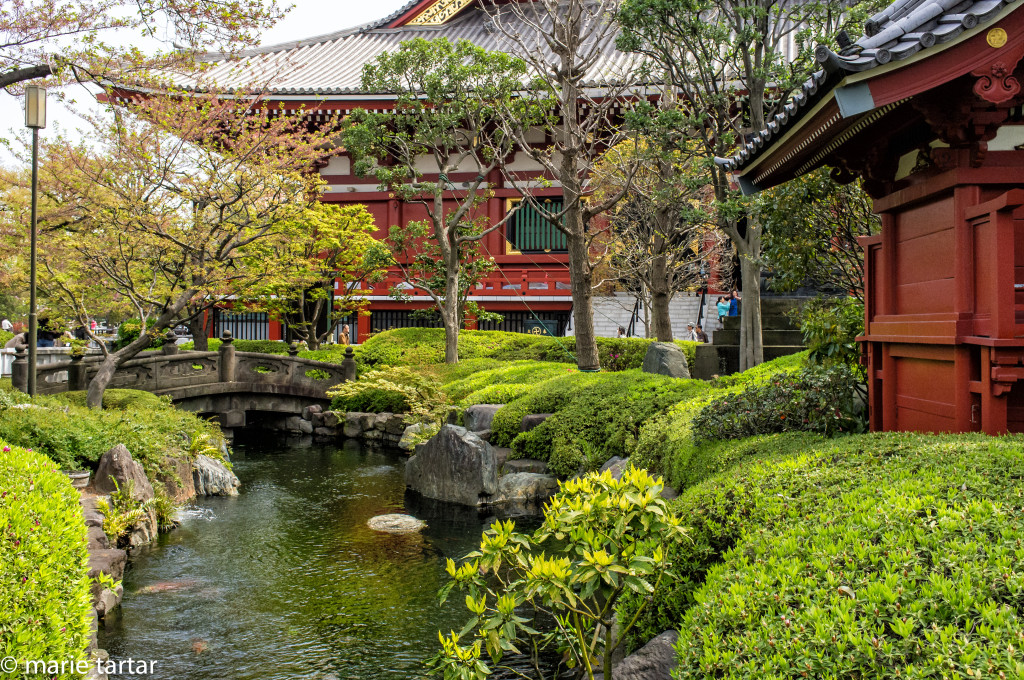
Despite being half Japanese, passing regularly through the airport en route to distant diving destinations, and 2 prior trips to Japan, we had never explored Tokyo at all, so we were clearly overdue. An unbelievably cheap airfare, without penalty for a stay over, enabled us to tack on a week’s stay in Japan’s capital to the back end of an Indonesian diving trip. The downside, of course, would be having All That Gear with us.
A red-eye from Jakarta left us sleep-deprived, cramped and achy, and not inclined to tackle the public transit system with our gear entourage. It being early on a Sunday morning, traffic wouldn’t be a factor, so we decided to take the easy way and cab into Asakusa from Haneda. With one big bag in front, and each of us balancing a backpack on our laps, we were off, our white-gloved cabdriver swiftly depositing us on a narrow street in Asakusa, in northeast central Tokyo, an area known as shitamachi, or low city. I had chosen this area to stay because it was not ravaged by either the Great Kanto earthquake of 1923 or the Allied firebombing of WW II.
What luck! Within hours of arriving, we found ourselves in the midst of a festival. Our ryokan is virtually in the shadow of Senso-ji Temple, and while orienting ourselves to our neighborhood for the week, we were engulfed by an annual festival, a matsuri. We later figured out it was the Shirasagi no mai, or white heron dance. It is a very stylized, ritualistic procession of women clad in gorgeous robes with pleated sleeves evoking bird wings , accompanied by a band which follows them in a wagon. The women wear headdresses of a long-necked white bird, which I initially interpreted as swans.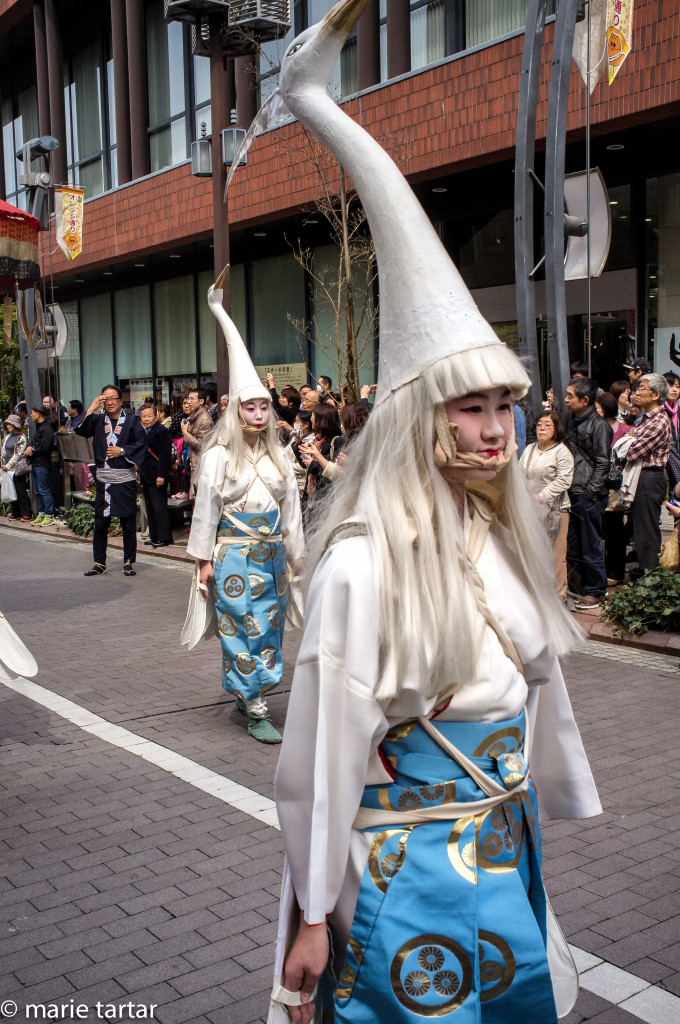 To hear the music and have a sense of the rhythm of the procession, here’s a short video segment: https://vimeo.com/95083360
To hear the music and have a sense of the rhythm of the procession, here’s a short video segment: https://vimeo.com/95083360
From the web, I later learned this “ceremonial parade” began in 1968 to commemorate the 100th anniversary of Tokyo as the nation’s capital.
“ The origin of this ritual dance is found in a historic picture scroll owned by Sensouji Temple, called Keian Engi Emaki, which depicts a ritual parade as a prayer for peace after the move of the temple. Three warriors, a pole carrier, a bird seed scatterer, a parasol carrier, eight white herons, 19 musicians, guardian children and others, are dressed in the traditional attire of the Heian period (the late 8th to the late 12th century) and the costume representing white herons. The slow, graceful movement of dancers beautifully reproduces the elegance of Heian manners…”
Through no advance planning or preparation, basically sheer dumb luck, we happened on both performances of this annual procession in the streets surrounding the temple grounds.
While exploring the surrounding area, including the plastic food and cook’s supply street, Kappabashi-dori , we happened by a restaurant whose name I recognized from my guidebooks, a well known destination for shabu-shabu. A participatory dinner at one of the best and oldest (since 1895!) shabu-shabu restaurants in Tokyo, perfect for the sleep-deprived and hungry! The pricing is based on the quality level selected, with Kobe beef commanding the highest price. We elected an intermediate level (still a rather pricy meal) and thought it delicious. Asakusa Imahan has private booths. Our waitress demonstrated the cooking technique for us after starting our water to bubbling and bringing platters of thin sliced beef, and vegetables, as well as mochi patties (rice cakes) and kuzukiri noodles (made from arrowroot starch). A few swishes in the hot water were enough to transform our beef slices from pink to luscious pale brown, then into one of the 2 sauces, sesame or vinegar based, and into our mouths. Some of the vegetables (carrots) could be left longer, while the mochi had to be carefully monitored-too long in the water and they stretched to unmanagability! The noodles were carefully scooped up with the chopsticks, noodle by noodle, and placed into a small basket to cook to translucency. Of course, after all these beautiful ingredients had passed the requisite time in the water, it turned into a delicious broth (periodically skimmed by our attendant).
It probably wasn’t very realistic to think we would get up pre-dawn to try to compete for tickets to the tuna auction at Tsukiji Fish Market, especially after a sleep-deprived night on the red-eye. We did manage to hit the streets while it was still morning, and headed to the Asakusa station to catch the Ginza line, all the way to the end, to Shibuya station. We had bought one Pasmo card the prior day, thinking we could use it for both of us, but that wasn’t the case. I was stymied by the vending machine trying to buy another Pasmo. I thought the problem was the bill quality or possibly the denomination, not noticing I was trying to feed it an Indonesian rupiah bill, which it repeatedly rejected! That Asian currency, with all those excess zeros, all looks the same…
The Shibuya crossing, aka the Scramble, is a crush of humanity, especially at commuting hours. The signals are coordinated so that pedestrians on all corners cross all at the same time, including diagonally, an impressive sight. This seems to be the Tokyo equivalent of Times Square or Piccadilly Circus in London, with the streets lit brilliantly by huge video screens and neon signs.  A few blocks away, a shopping center tower, Shibuya Hikarie, was comparatively subdued, with a terrific selection of restaurants on floors 6-8. We decided on Korean food for lunch, lest Steve get burned out on Japanese food like on our last trip to Japan. We shared bibimbap, and Korean barbeque beef, which really hit the comfort food spot. This being Monday, most museums are closed, but we did attempt to hit some alternative cultural destinations. The Tomio Koyama gallery on the 8th floor featured a show of small paintings by Victoria Gitman called “On the Surface”, lushly realistic, detailed renderings of beautiful beaded evening bags. Although I didn’t know her work, flipping through catalogs in the gallery, I saw familiar names, indicating her work is included in MCASD’s collection, as well as a forward by Leah Ollman.
A few blocks away, a shopping center tower, Shibuya Hikarie, was comparatively subdued, with a terrific selection of restaurants on floors 6-8. We decided on Korean food for lunch, lest Steve get burned out on Japanese food like on our last trip to Japan. We shared bibimbap, and Korean barbeque beef, which really hit the comfort food spot. This being Monday, most museums are closed, but we did attempt to hit some alternative cultural destinations. The Tomio Koyama gallery on the 8th floor featured a show of small paintings by Victoria Gitman called “On the Surface”, lushly realistic, detailed renderings of beautiful beaded evening bags. Although I didn’t know her work, flipping through catalogs in the gallery, I saw familiar names, indicating her work is included in MCASD’s collection, as well as a forward by Leah Ollman.
Our next stop was a large department store, Parco, ostensibly for the Parco Museum inside, featuring pop culture exhibits. What we could see of the beginning and end of the offering, Kiki & Lala X Care Bears, convinced us to pass. The store itself had other offerings of interest, housing multiple boutiques, and I found some clothes at pas de calais and Adam et Ropé. I wasn’t familiar with either of these brands. Interestingly, researching them later, I found they both are Japanese lines with French connections.
Although there is a pas de calais store in NYC close to where we stayed in Soho in December, I never made it inside, always passing by either too early or too late. The designer is a Japanese woman, Yukari Suda, who draws inspiration from the region in northern France of the same name. Adam et Ropé, although a French sounding name, is a Japanese label, but has previously collaborated with Agnès B, a favorite French line. Funny, one of my favorite stores in Paris is a consortium of Japanese designers, Norie M. Seems when I’m in Japan, I’m drawn to those Japanese lines with French associations.
Approaching the golden light of late afternoon, it was time to hit the streets, namely Center-Gai, a pedestrian artery in the heart of Shibuya, thronged at commuting hour and brightly illuminated by a riot of colorful signs and screens. 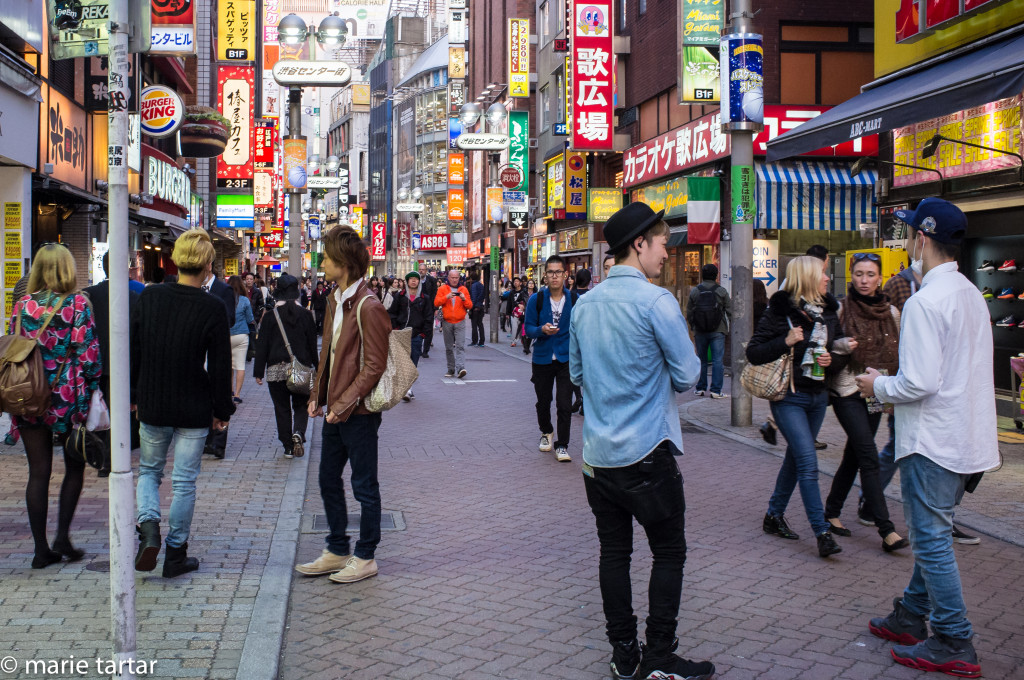 Looking for a rubber band, we headed into Tokyu Hands, which seems to be the BHV of Tokyo, 8 floors of every imaginable item for the home, repairs, projects, you name it. When the light began to fail, we headed north to Omote-Sando, a tree-lined upscale boutique lined boulevard, lined with dramatic contemporary architecture.
Looking for a rubber band, we headed into Tokyu Hands, which seems to be the BHV of Tokyo, 8 floors of every imaginable item for the home, repairs, projects, you name it. When the light began to fail, we headed north to Omote-Sando, a tree-lined upscale boutique lined boulevard, lined with dramatic contemporary architecture.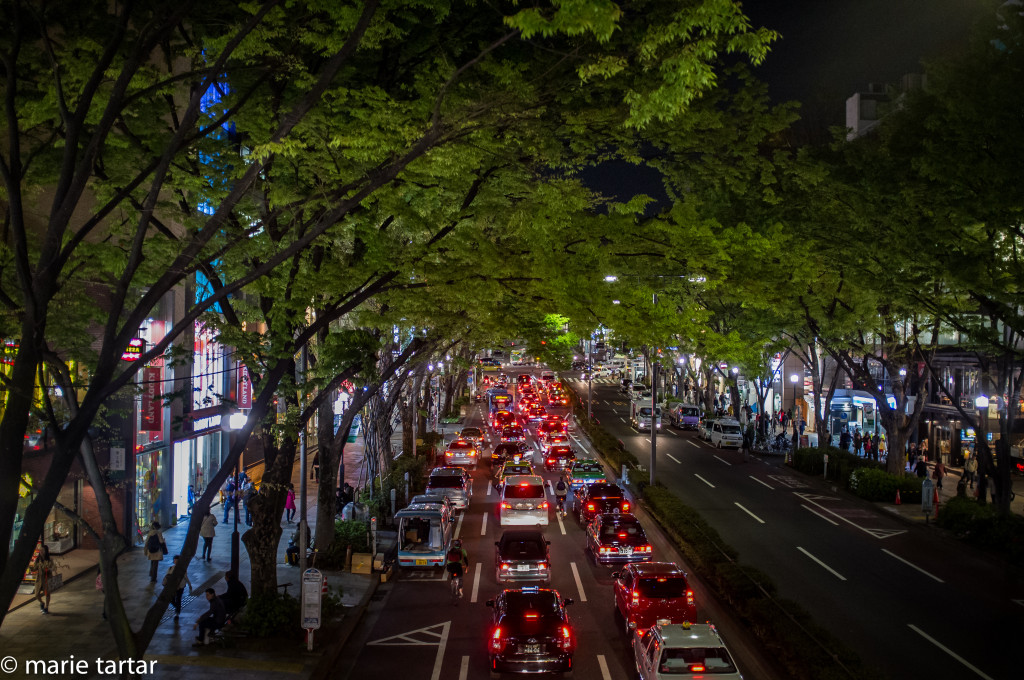 It was great to see it at night, as many of the buildings, by a who’s who of contemporary architecture, are dramatically lit.
It was great to see it at night, as many of the buildings, by a who’s who of contemporary architecture, are dramatically lit.  Foremost among these are the 2003 lightboxes of Dior ( Pritzker Prize winning firm SANAA (Sejima Kazuyo and Nichizawa Ryue-one can clearly see a resemblence to their design for the New Museum of Contemporary Art in NYC) and Prada (Herzog and de Meuron).
Foremost among these are the 2003 lightboxes of Dior ( Pritzker Prize winning firm SANAA (Sejima Kazuyo and Nichizawa Ryue-one can clearly see a resemblence to their design for the New Museum of Contemporary Art in NYC) and Prada (Herzog and de Meuron).
We also loved the muscular and sculptural Toyo Ito building for Tods.
We spent the next day exploring Ginza. No, we still didn’t make it to the fish market, but fresh fish was the driver for the day, namely a coveted reservation for lunch at Sushi Mizutani, a tiny, 3 Michelin star sushi experience. One of three 3 star sushi restaurants in Tokyo (the other 2 being Sukiyabashi Jiro of “Jiro Dreams of Sushi” fame and Sushi Saito), I first learned of it from a New York Times article last fall as one of 3 never-miss-on-a-visit restaurants of a Northern California chef and Tokyo regular, David Kinch. I found interesting his take on the rice seasoning and temperature being the real discriminator among the haute sushi practitioners, and at Sushi Mizutani, the rice was indeed outstanding and simply scrumptious.
Chef Hachiro Mizutani has collected many accolades for his 10 seat restaurant, in its current location for the last 2 years, on the 9th floor of the Juno building in Ginza . In addition to being accorded the #27 spot in the Asia’s Top 50 Best Restaurants in 2013, it was also named one of the Top 5 Tokyo sushi restaurants by Lifestyle Asia in June 2013. Before opening his own place, the chef worked for Jiro, as well as at Yoshino.
Of course, I would love to have been able to eat at Jiro’s, but was somewhat put off by descriptions of 20 minute meals, and getting a reservation seemed very daunting. In fact, booking any high end Tokyo restaurant was more difficult than anticipated, as many will not accept reservations from overseas. In the end, I wrote our hotel and asked them to try for all 3 of the restaurants mentioned in the article, this one coming through.
My reading on the web before our departure had primed me to expect a hunt to even locate the restaurant, so we set off in plenty of time. Ginza was the first area in Tokyo to build brick, Western style buildings, and as a high end shopping destination, is the usual launching grounds for western companies looking to open their first outpost in Tokyo (example: Starbucks). There were many familiar French names as well, including the Parisan bakery Dalloyau, where we had a few tasty morsels to tide ourselves over, including a distinctly non-French offering, filled with sweet red bean paste.
Huge, gorgeous department stores abound in this area. Having located the restaurant by 11 am and assured ourselves of an on time arrival, we were first draw in by a gorgeous knee-length, sawtooth hemmed, navy blue sleeveless Alaïa dress in the window of Barney’s. Both Steve and I were thunderstruck by the magnificence of Alaïa’s creations at the retrospective we saw in Paris in January, so I couldn’t resist the opportunity to try one on. It fit perfectly, although was so form fitting, it required the assistance of the salesgirl, lest I overstep the bounds of my shoulders’ comfortable range of motion. Even lopping off 2 zeros to the pricetag, it was a lot of dress, about $3000. Thankfully, it was time to go to lunch, so that put an end to temptation. For a while.
Our lunch at Mizutani’s was practically a private audience. There were 2 other diners there, both Japanese, one of whom finished fairly early into our stay, while the other, seated next to me, spoke some minimal English. The chef really doesn’t speak English, so I was able to exercise my limited Japanese. The decor was austere and serene, while the atmosphere was welcoming. Toward the end of the meal, with the aid of the other client, we were told the wooden bar was formed from a single tree and cost $6 million US. This hardly seemed possible, so I assume there probably was something lost in the currency conversion, maybe those 2 decimal places moved the wrong direction, which would still be quite pricey for a wooden bar, albeit quite an attractive one.
I started with sashimi and moved on to sushi, while Steve elected sushi. The sashimi was served with soy sauce, which was withdrawn when we were on to the sushi. It was fascinating watching Mizutani’s precise and practiced, economical movements and knifework. The sous-chef ground the wasabi root into a flat copper grater, but without perforations, lest the juice escape. It is extremely rare to be served fresh grated wasabi in a Japanese restaurant in the US, and I had never seen how it was prepared. The only place I recall having it is Nobu’s Matsuhisa, and we usually have to ask.
The sashimi was superbly fresh, but I had to agree that the sushi, the combination of fish and rice, really sang. Standouts for me were the mackeral and the uni, with many courses being new and unfamiliar, such as Japanese cockles. Surprisingly, I loved the tamago (egg) which was the final offering, a stand in for dessert. It really was delicious, sweet, smooth and more like a creamy cake than any egg dish I’ve ever had.
Toward the end of the meal, the chef, chatting with the remaining Japanese customer, brought out a special knife in a silk wrapping. It was beautiful, signed by the maker and I caught a reference to Seki, my mother’s home village and a traditional knife making town, in their conversation.
The price tag for perfection? 49,000 yen; yes, a lot of zeros, about $480 US, including a draft beer for Steve and green tea. I had been forewarned by my reading of a post on the blog “Tiny Urban Kitchen” that they don’t take credit cards, so part of the morning’s advance preparations included a trip to the ATM. Dinner is even more expensive, so lunch seems a good option and is definitely an easier reservation to snag.
After lunch, we continued our explorations of Ginza, which means more stores than museums, but in Tokyo, it seems fashion and art really are fused, at both the high and the low end.

This Uniglo display bore a striking resemblance to objet d’art I saw in the Dynamo show in Paris last year
We started at Uniglo, which I had never really explored before. They collaborate with artists, estates of artists and museums to produce limited edition T shirts and tanks at astounding prices, $10-15. I tried on a sack full, by Jonathan Adler, Ryan McGinness (who we met through our friends Ralph and Gail in December), Keith Haring, Andy Warhol, Jackson Pollock, and ended up with a couple, including one from a whole line produced in association with Inès de la Fressange, French style icon (again that French connection!).
Then we wandered around, looking for Dover Street Market, which my guidebook describe as a “department store as envisioned by Rei Kawakubo of Comme des Garçons,” which sounded intriguing. It couldn’t have been closer, literally joined to Uniglo by skybridge. The installations were art themselves, not to mention the clothes, by a variety of Japanese designers, and…Alaïa! And, a Paris favorite, Rose Bakery, on the top floor!
By mid-week, we were ready to delve further into the intricacies of the transportation network, beyond the subway. Seeking out the Japan Folk Crafts Museum (known in Japanese as Mingeikan), beyond the Komaba campus of Tokyo University, required heading to the end of the Ginza line, to Shibuya, and then boarding a local Inokashira line train for 2 additional stops. The campus was relatively quiet, but still had sakura (cherry tree) blooms, and it was just a short walk to the museum. We lucked out (dumb luck again, certainly not planning) in that we chose to visit on one of the 4 days a month (2nd & 3rd Wed & Sat) that the West Hall or Long-Gate House, across the street, was also open. Steve and I agreed afterwards that this was our favorite part of the complex, a beautiful Japanese house, occupied for years until his death by the philosopher and driving force behind the mingei movement, Soetsu Yanagi (1889-1961). He designed both buildings, the Main Hall to be the home of the Mingeikan collection, harmonizing with his home.
The Main Hall is a gorgeous example of traditional Japanese residential architecture, with a double staircase mounting from the entrance. The objects, including ceramics, paintings, and textiles, are displayed intentionally with minimal signage, just a small laquered plaque, with the aim to encourage the visitor to focus on the object’s form without prejudice or foreknowledge. In our case, since those small plaques were entirely in kangi (no English, romaji or even hiragana), we certainly saw the objects without pre-conceived ideas!
On the way back to the train station, we happened on a bakery that drew us in. It was a French bakery, Le Ressort, with crispy baguettes to rival the best of Paris. We scooped up a couple of delicious chicken sandwiches with roasted tomato, as well as a selection of goodies incorporating hazelnuts, figs and proscuitto, intended for breakfast the following morning. They were so delicious, they mysteriously vanished over the course of the afternoon. The next time I looked in our bag, they were MIA.
Back in Omote-sando, we wanted to see Spiral Building by Maki Fumihiko, so named for it’s internal spiraling art gallery ramp. There was a nice gift and homewares shop, Spiral Market, on the second floor.
We intended to finish the afternoon at Nezu Museum in Omote-sando, but were dismayed to find out at the gate that it wouldn’t reopen from installing a new show until Saturday. Heading back up Ometo-sando, we turned down Cat Street, a nice human scale pedestrian street filled with cafes, resale shops and young people. An architect we chatted with the evening we did our first tour of Ometasando had mentioned it as worth a stroll.
From there we were off to another signature Harajuku street, even signed on both ends, Takashita-Dori, known for its outrageous teenage fashion scene.
For dinner, we had reserved a Kyoto small plates meal at Kuranosuke Ginzasukiyaten. A few weeks before our trip, I met a young radiology technologist who lived in Tokyo for years teaching English, and had asked if he had a favorite restaurant and this was his suggestion. The staff were most welcoming. This clearly wasn’t on the tourist radar at all, as the menu was entirely in Japanese, and I mean Kangi (Chinese characters), with no helpful pictures, English version, romaji or even hiragana. Luckily, I have that Japanese word, omekase (chef’s choice) down, so we just sat back and let them bring us plates. What they brought: a twisted seasnail (top shell, I think, after consultation with the internet), which Steve wouldn’t touch, avocado, tomato and salmon salad; fried burdock (a root vegetable my mother likes, looks like a thin brown carrot, like the most delicious french fries ever, but stayed hot much longer), chicken and a brown crispy crusted onigiri (delicious). The price was most reasonable, including sake for me and beer for Steve, less than $60.
Still didn’t get up in time on Thursday to be there right when the Tsukiji fish market opens at 9 am. Instead we decided to seek out a calmer side of Tokyo, guided by a walking tour of Yanaka which I had found on the National Geographic Traveler website. Yanaka is distinguished by its intact past, being one of the few places in Tokyo not ravaged either by the Great Kanto earthquake in 1923 (beautifully depicted, by the way, in the gorgeous recent last film of Japanese animator Hayao Miyazaki, The Wind Rises) or the Allied bombing and fires of WW II.
We thoroughly enjoyed the walk on the peaceful side of Tokyo, a marked contrast to the intensity of Shibuya and Harajuku. Starting at Nippori station, our route took us past many quiet but lovely temples, including Keio-ji and Choan-ji, their classical Japanese structures set off by pink trees still bearing sakura blossoms.  Yanaka Ginza, a neighborhood shopping street, felt very unaltered from how one could imagine it in the pre-war years.
Yanaka Ginza, a neighborhood shopping street, felt very unaltered from how one could imagine it in the pre-war years.
Both in the temple grounds and in Yanaka Cemetary, there were interesting vertical gravestones, entombing ashes of the cremated departed, with inscriptions on wooden planks indicating familial visits on auspicious dates. Yanaka Cemetary is home to many notables, including the last shogun of the Tokugawa clan.
A surprising highlight was the house and studio turned museum (Asakura Museum of Sculpture) of Japanese sculptor Fumio Asakura (1883-1964), a towering figure of Japanese 20th century sculpture. His work seemed strongly in the figurative tradition of Rodin and Maillol. Although he never studied abroad, his work is so sympathetic to contemporary European sculpture, that he surely must have been aware of this work. In fact, after the death of his professor, a specialist in European art history, he acquired his large library of western books, saving the collection from dispersal to second hand book stores.
From the outside, the house was intriguing, painted black, with curved walls and other subtly Art Deco elements, consistent with it being built in 1935. It was designed by Asakura and enlarged over the years. In addition to being his home and studio, it also served as home for his school for sculpture students. The glorious surprise awaited us inside, with the Japanese-style building surrounding a water filled central garden, accented by huge sculptural rocks imported from all over Japan. The house abounded with beautiful Japanese elements and details, and apparently, he was a hard master for the craftsmen to satisfy.
It was mid afternoon and we were starved by the time we made it down into Ueno Park and the mammoth Tokyo National Museum. A quick lunch at the cafe left us just 1.5 hours to scratch the surface of Japan’s Metropolitan Museum, just long enough to tour one floor of one building, highlights of Japanese art.
Dinner was at a well known local tempura restaurant, Daikokuya, but we weren’t wowed. Of course, my standard is Mama’s tempura, which has a very crispy panko coating and emphasizes vegetables. This tempura seemed more egg-y, and came packed together enough that the coating, while tasty, had a soggy texture. The only choice was how many prawns, with or without a fish and shrimp mixture, with one lonely shishito pepper for a vegetable. I enjoyed the side dishes more, pickled daikon, as well as a side dish of grated daikon and mushroom.
Down to the wire and time for the fish market. Tsukiji is planned to be moved next year. Our run of beautiful spring weather and sun came to an end, as the day dawned cold, and rainy. Tsukiji is huge, and thronged with people and activity. 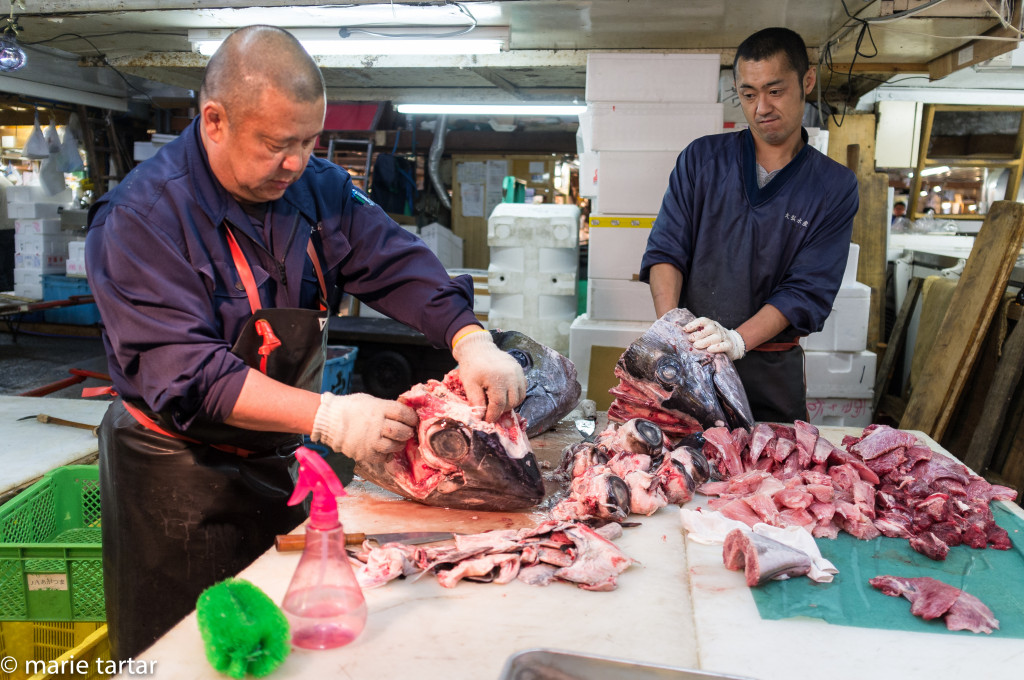 Housed in a cavernous covered open warehouse space next to the Sumida River, it bustles with activity and requires close attention in order not to be run over by bicycles and zooming trolleys, collide with workers or other tourists, or have your feet splashed with fish guts and water as the workers clean up for the day.
Housed in a cavernous covered open warehouse space next to the Sumida River, it bustles with activity and requires close attention in order not to be run over by bicycles and zooming trolleys, collide with workers or other tourists, or have your feet splashed with fish guts and water as the workers clean up for the day. 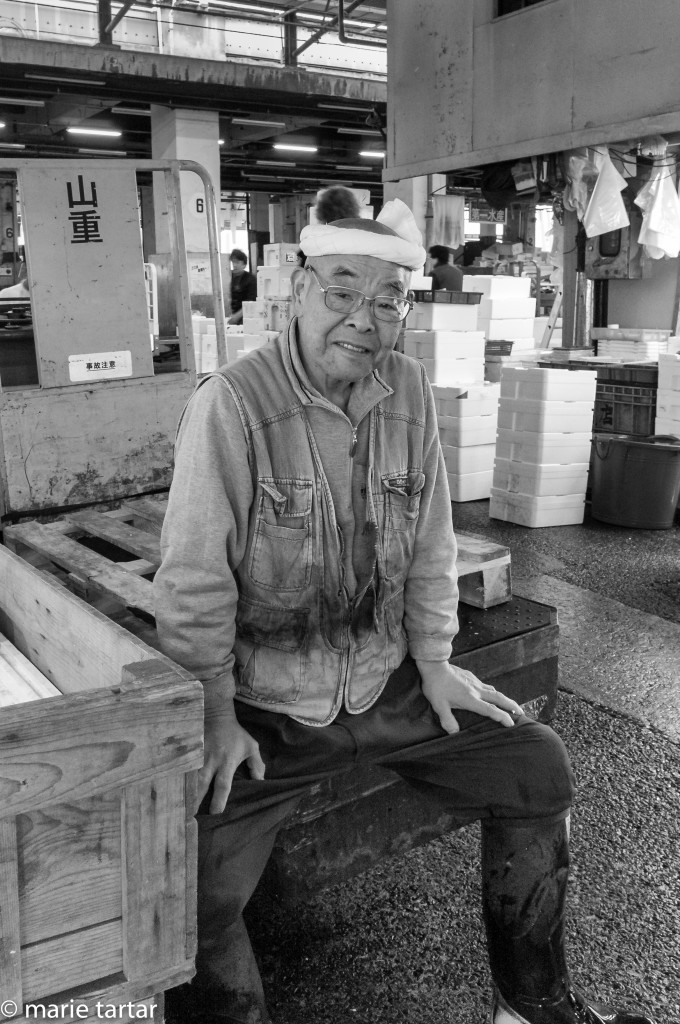 It is truly an impressive sight, and both Steve and I found our inner foodies in direct conflict with our underwater photographer/conservation minded alter egos.
It is truly an impressive sight, and both Steve and I found our inner foodies in direct conflict with our underwater photographer/conservation minded alter egos. 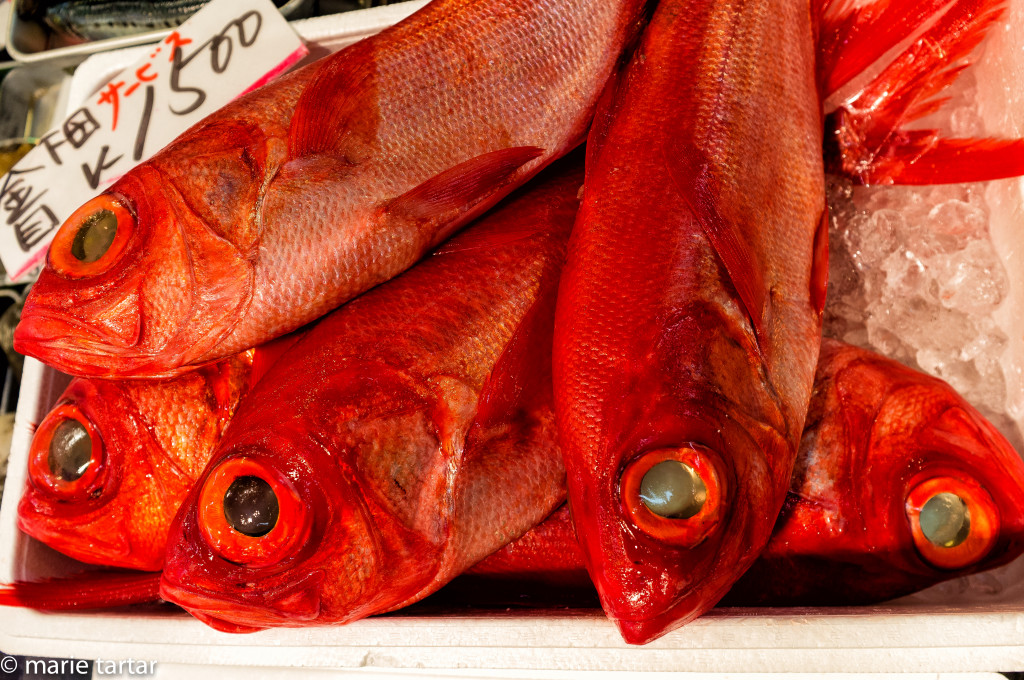 The sheer mass of sea creatures on offer here for consumption is mind-boggling.
The sheer mass of sea creatures on offer here for consumption is mind-boggling.  It doesn’t seem sustainable at all.
It doesn’t seem sustainable at all.
It was quite fascinating to watch the workers scraping fish scales, microtoming skin off of VERY expensive fish, interacting with their customers, packaging up orders and all the other activities of the world’s busiest fish market.
The tourist tradition is to have a sushi breakfast to follow in one of the many outer markets restaurants, but we couldn’t muster the appetite for sushi, especially since the outdoor wait would be long and cold. I did find a hot bowl of udon at one of the outer market stalls to warm me up, before we headed to our afternoon’s destination, Tokyo Metropolitan Museum of Photography.
From Ebisu station, we could stay out of the cold on a long Sky Bridge which led to the plaza in which the museum is located. The pricing was based on the number of shows you wanted to see-there are 3 floors of exhibitions, each housing a different show. We decided to see them all. (As an aside, the subway is similarly priced, by length of ride, with Pasmo scans when you enter and exit automatically calculating and deducting your fare.)
One of the three featured a familiar name, Magnum photographer and well known conflict photographer Robert Capa, 2014 being the 101st anniversary of his birth. The other two shows featured Japanese photographers we didn’t know at all. We both admired the work of alpinist Hokari Masuo in a show of black and white landscape photography called Valleys and Peaks. His work in Japan’s Northern Alps strongly resonated with Ansel Adams’ work in Yosemite.
The third was A Retrospective of Shimooka Renjō: 100 Years after his Death (1823-1914), a pioneer of photography in Japan. Beginning and ending his career as a painter, he was exposed to photography by chance while Japan was still closed to outsiders, and had to wait for years for instruction and work out the technique through his own experimentation before beginning it as a business. His photographs are some of the earliest available of life in Japan, beginning in the 1860s.
Our final stop was at the Takashimiya department store. The NYC store on Fifth Avenue was a favorite (now closed), and the legendary basement food court of the flagship store beckoned. And what a frenzy it was! Equally frenetic as the morning’s visit to Tsukiji, with scores of well dressed, mostly Japanese, shoppers, queuing up for baked goods, gyoza, cheese, salads, tempura, almost any delectable edible imaginable, to the high pitched music of young greeters, “Irasshaimase” (welcome!), passing out samples. One stall had multiple choices of sticky rice: savory, with mushrooms, carrots and taro or perhaps with sour dried plums and ginger? Delightful dilemmas presented themselves at every turn. The only downside: there appeared to be no option to eat on site, no seating not attached to a restaurant.
Our final morning, we found ourselves down to our last yen. Although we tried numerous ATMs, we couldn’t find one that would recognize our card. In fact, the only ATM we had success with on this entire trip was a Citibank branch in Ginza, thankfully just in time to raise the sum necessary to fund our cash only sushi extravaganza at Sushi Mizutani. Luckily, we found 2 small free museums in the neighborhood, while wandering around trying to find an ATM. One was particularly interesting, the AMUSE museum, just east of Sensoji, with exhibits of traditional clothing and textiles of the snowy north Aomoyi, BORO, made of scraps of cloth and hemp in a region where cotton and wool were difficult to obtain and nothing was ever wasted. Some of the garments were used for generations, added on to as they wore out, patched and repatched, acquiring a quilt-like panache over the years. This collection was amassed by Chuzaburo Tanaka, an ethnologist whose solitary efforts at preservation of these textiles and garments were eventually recognized as important, receiving designation as national tangible cultural property. He also supplied director Akira Kurosawa with clothing for use in his film “Dreams.” Also of interest to the textile enthusiast were elaborately embroidered maekake aprons of the Nanbu.
How to return to the airport with our mounds of gear? Narita is far from Tokyo. Cab fare would probably be north of $200, and no insurance against traffic jams. With a normal amount of luggage, this would be a no-brainer: cab or subway to either Ueno or Nippori station, then Keisei Skyliner to Narita, an express train traveling at Shinkansen-like speed, 41 minutes from Ueno, 35 from Nippori. Since this train services only the airport, it is designed with travelers in mind, with reserved seating with lots of legroom and baggage storage. I decided we were up to the challenge of managing dive gear and public transit, up to a point. We stuffed ourselves and our bags into a cab (1 large bag in the front passenger seat, 1 large bag between us in the back, and each of us holding our backpacks on our laps, 3 bags in the trunk) and headed to Nippori station. This station seemed more manageable and less of a zoo than Ueno when we had passed through it on our Yanaka walking tour a few days before. This proved to be a good option, which I would do again. Twenty dollars cab fare to the station, then $44 total train fare for both of us to Narita, and not too difficult to negotiate with our bags in tow, the Portercases holding our underwater cameras now serving as luggage caddies.
An improbable encounter between my seatmates took place with me as the intermediary. I had decided at the last minute to secure a “premium economy” seat, a middle seat in an exit row, so no seat in front and lots of leg room. Steve had an aisle a few rows ahead, and I would have been in an extra-tight middle seat, as the man in the window seat was sizable (as soon as he was seated, he asked for a seatbelt extension). In my new, improved middle seat, a young man in his 20s was in the window seat, chatting with a woman about my age in the aisle seat. Turns out, they both had recently been in Fukuoka. The man was returning to the US after having a second, Japanese wedding ceremony there, to a local Japanese girl. The woman had taken a city tour there, and his comments about being there for his wedding, being from Washington DC, etc caused the woman to start, and to begin digging in her purse for her phone. Producing a photo of herself with several other tourists in front of a temple, she showed it to the newlywed, who laughed and said “That’s my mother!”
The on board entertainment system, the movie buff’s best friend for catching up, helped passed the hours. The gorgeous film translation of a book I loved, “Memoirs of a Geisha,” was certainly well deserving of its Oscar for best costume design. My last movie was a hidden gem from Japan, called “Mourning Recipe”, and had me crying for an embarrassingly long stretch, going through every tissue in my little travel purse and wishing for more. A wife and stepmother leaves behind a cookbook of sorts to help her family negotiate their way through their grief, as they plan a party for her 49th day send-off to the afterworld.
From beginning to end, we found a lot to like in Tokyo. Not the prettiest city in the world, a real architectural mash-up, but vibrant and electric in its variety and exciting street life. I’m already rethinking our planned fall family trip with Mama to include a few more days to dig deeper into the intriguing maze that is Tokyo.
-Marie
Restaurants to try next time:
(David Kinch’ other 2 never-miss-when-in-Tokyo choices that we didn’t get to):
Ginza Kojyu (omakase), closed Sunday
Ishikawa, closed Sunday, 5:30 pm-12 pm; 81 3 5225 0173
(recommendations from my foodie francophile friend Arie)
Tsunahachi tempura bar
Tonkatsu Tonki, in Meguro

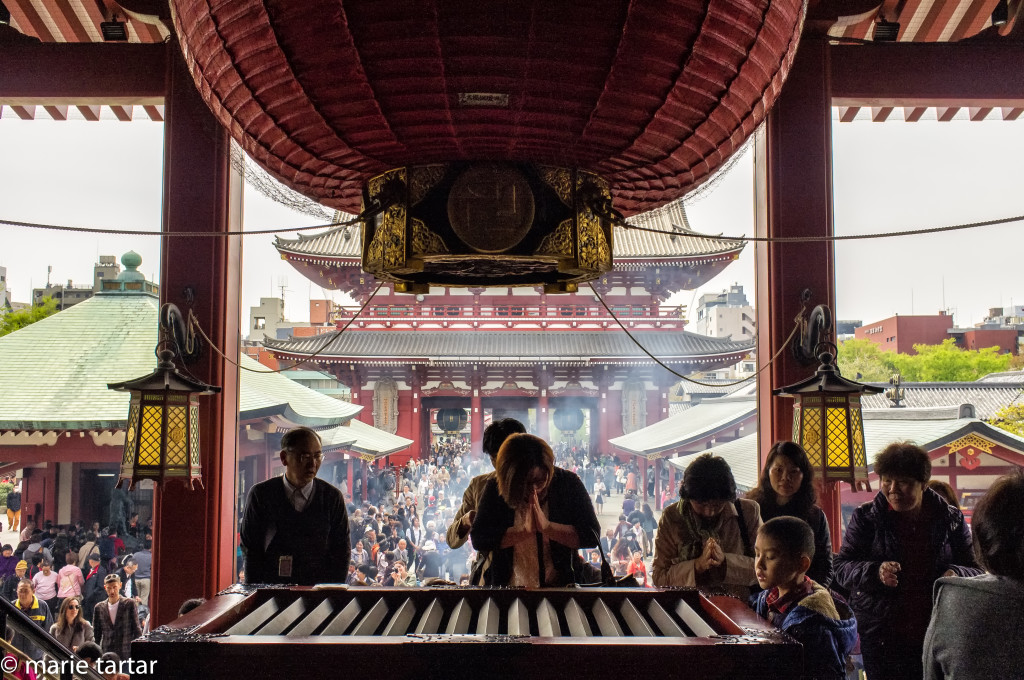
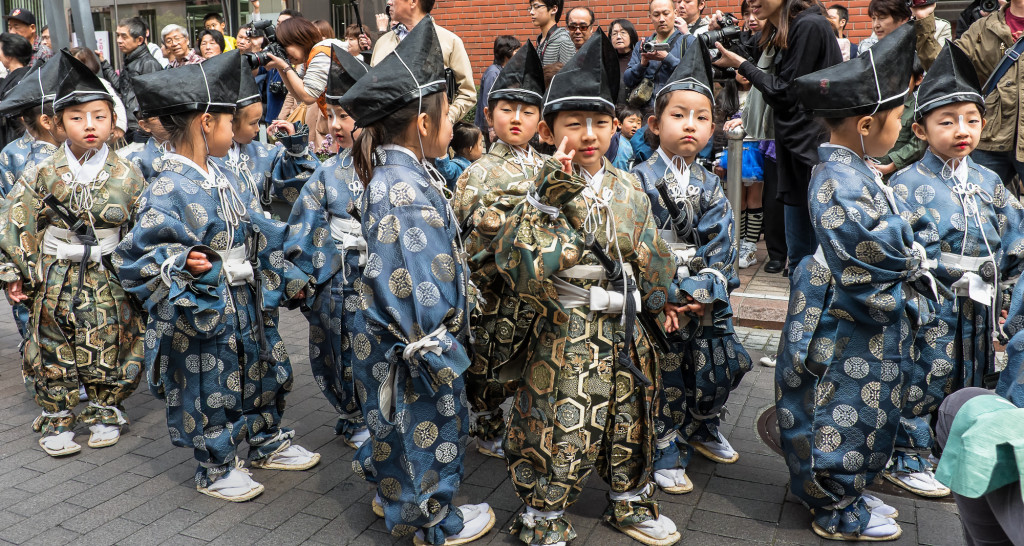

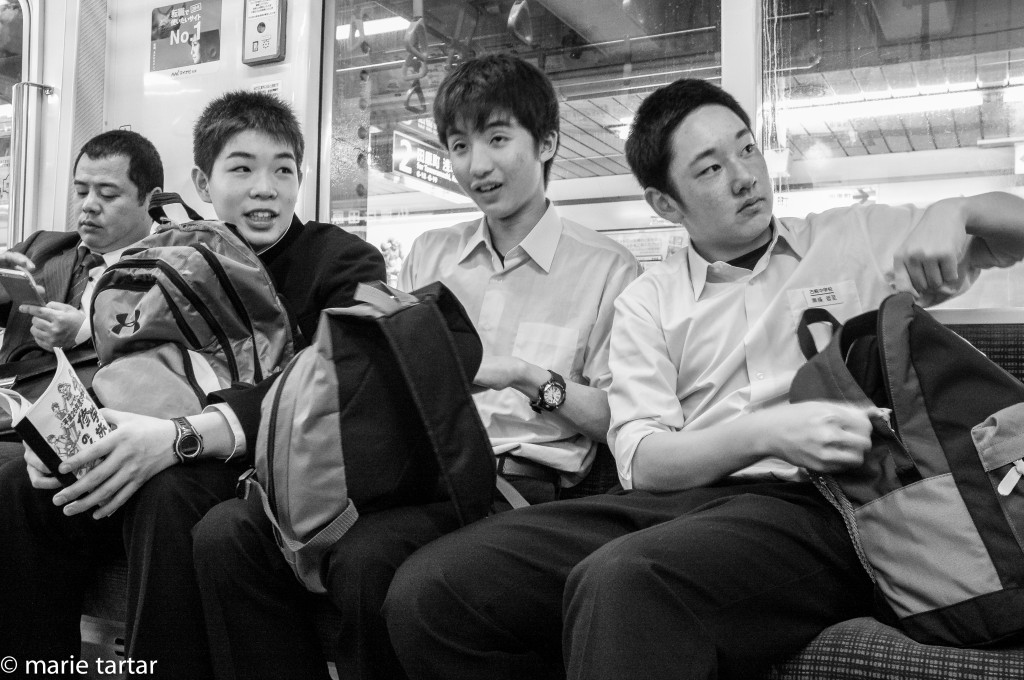
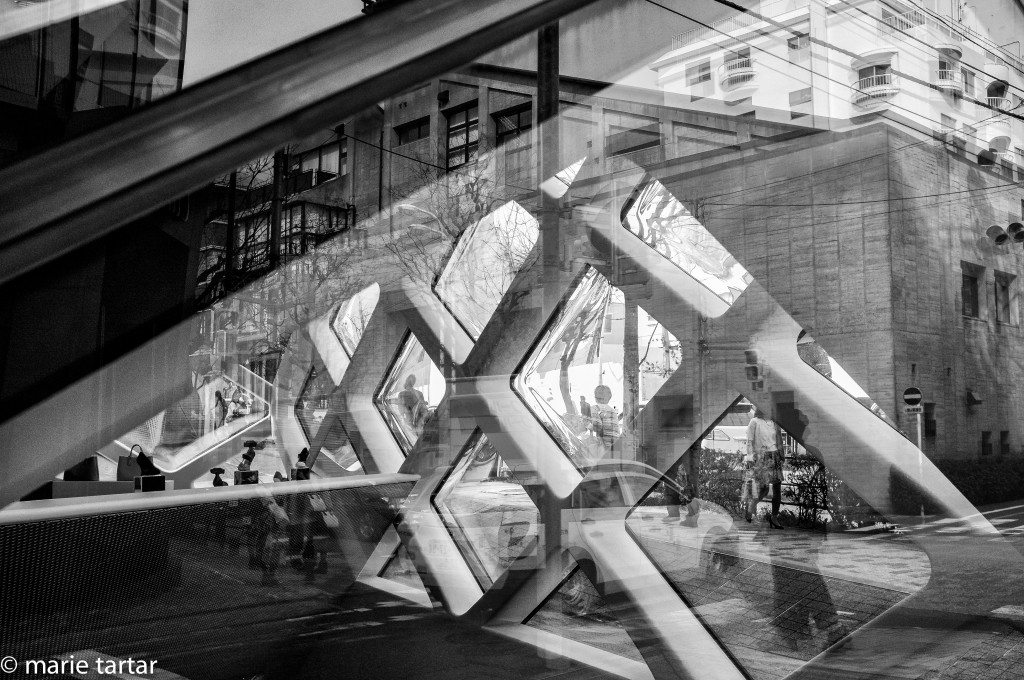
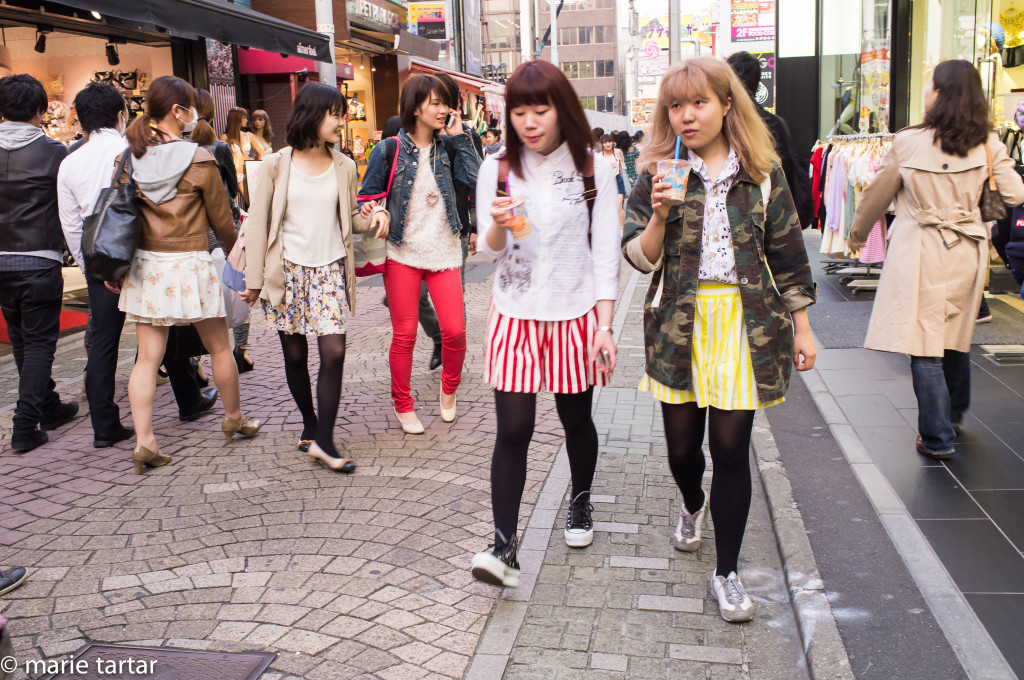
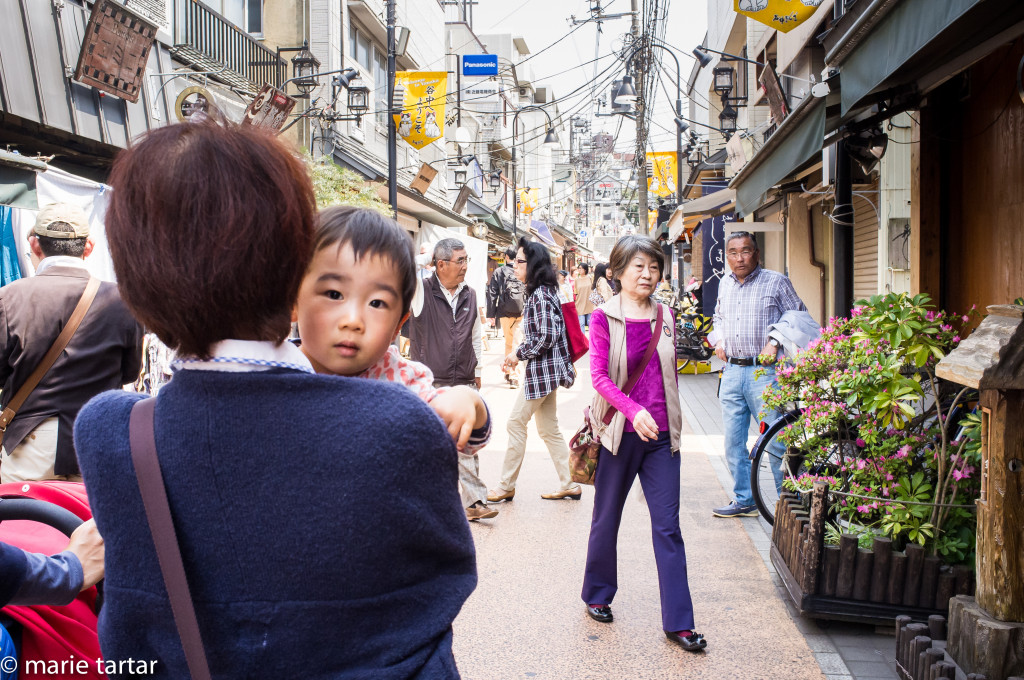
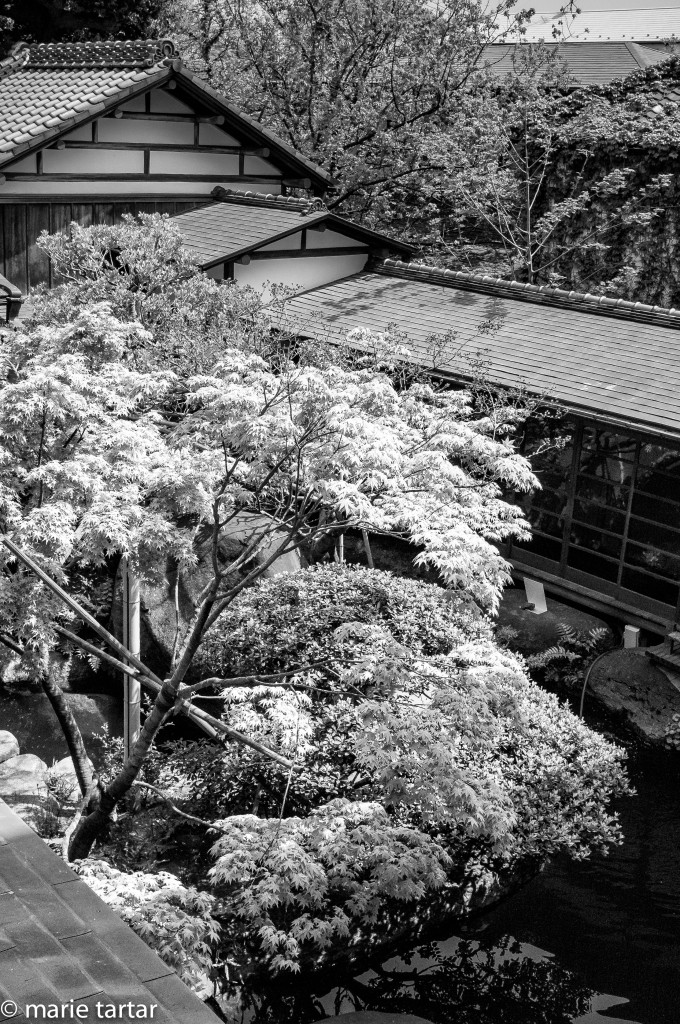

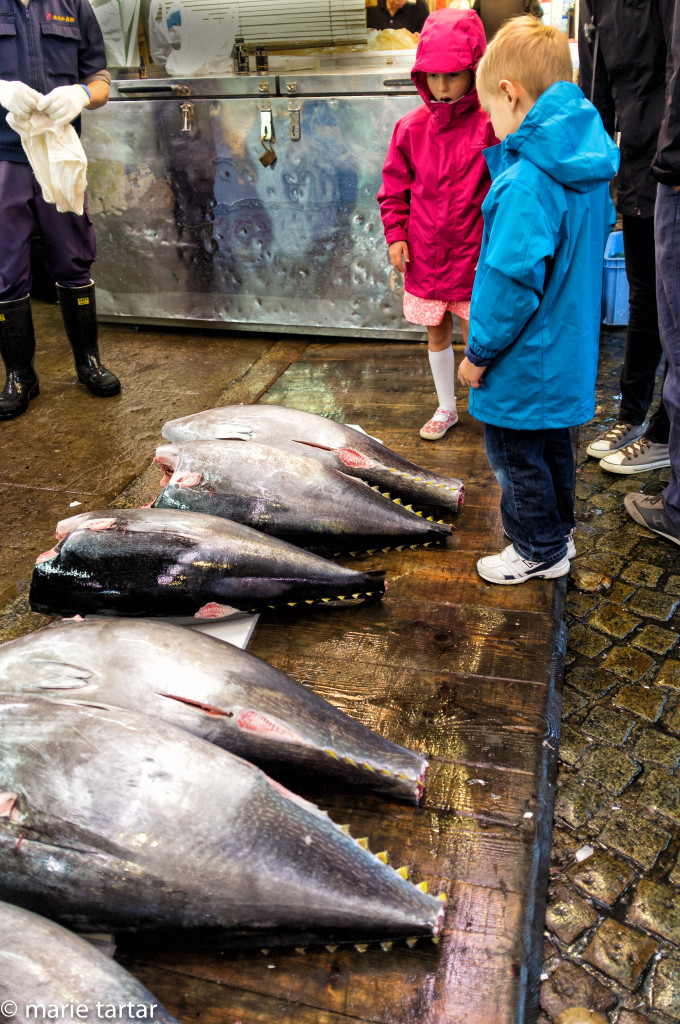

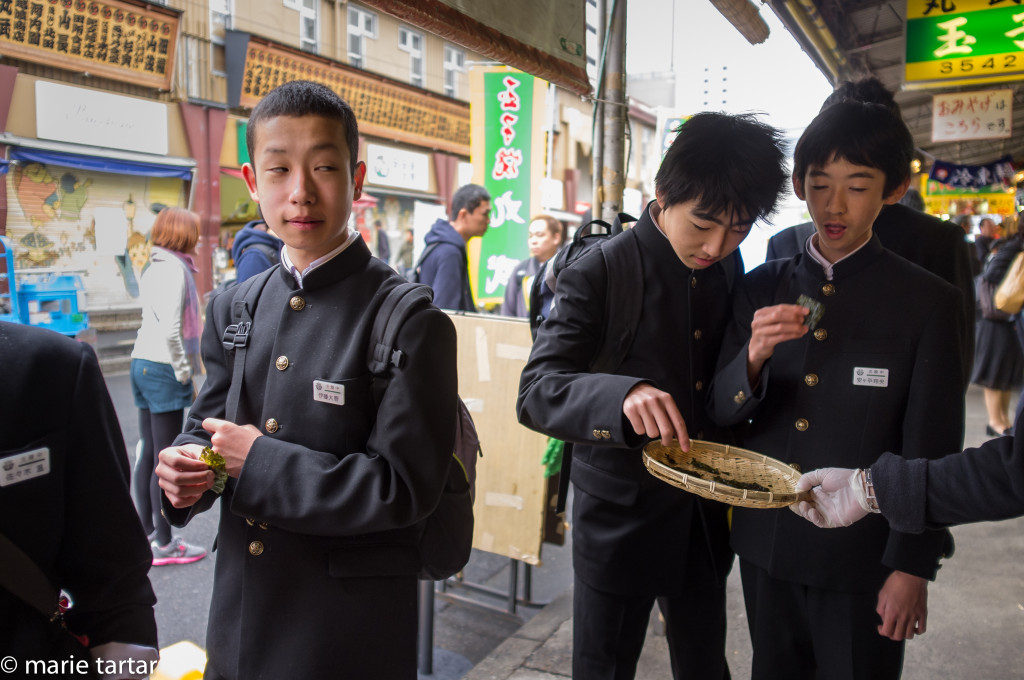
Marie-
Another great full-service travel blog – amazing pictures and viivid, detailed prose. Thank you.
-Martha
I’m planning to visit Tokyo around Christmas this year. The temples you’ve mentioned look really beautiful.